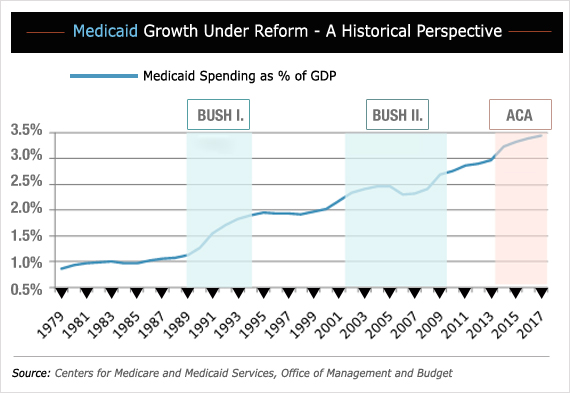Justice Stephen Breyer seemed unsure of his facts last week.
During oral arguments on the constitutionality of health care reform, he suggested that the law’s Medicaid expansion, which will offer government coverage to about 15 million low-wage workers and their families, was smaller than previous expansions – notably, the change of the late 1980s and early 1990s, which brought all poor children under Medicaid’s umbrella; and one enacted in the late 1990s and early 2000s that included children up to 200 percent of the poverty level.
RELATED: GOP Plan Would Cut Medicaid Funding to States by 34%
“The expansion from 0 to 18 or even 0 to 6 . . . it’s pretty hard to argue that they aren’t roughly comparable as a percentage of the prior program or as a percentage of GDP (gross domestic product),” he said to Paul Clement, the eloquent litigator who represented the 26 states challenging the Medicaid expansion as unconstitutional coercion of the states. “If I’m right on those numbers, or even roughly right – I don’t guarantee them – then wouldn’t you have to say, well, indeed, Medicaid has been unconstitutional since 1964?”
Three things made the proposed expansion under Obamacare unique, Clement replied in his rebuttal. “One is the sheer size,” he began. “Two is the fact that this statute uniquely is tied to an individual mandate, which is decidedly non-voluntary. And three is the fact that they’ve leveraged the prior participation in the program.”

If the high court rules the individual mandate is unconstitutional, it’s highly unlikely they would expand that ruling to include Medicaid’s expansion. The joint federal-state program is financed by taxes. So unlike the economics of insurance regulations, Medicaid does not require a mandate to be sustainable. All the government has to do is raise taxes.
As for leveraging prior participation in the program (the failure to cover the uninsured eligible for Medicaid could jeopardize other federal Medicaid funds), even Chief Justice John Roberts was dubious about the logic that would make that an act of unconstitutional coercion. “They should not be surprised that the federal government having attached . . . strings . . . isn’t going to start pulling them,” he said.
But to the core point of size, it turns out that Breyer’s back-of-the-envelope calculations were spot-on. The expansions of Medicaid in the late 1980s that offered coverage to all poor children not on welfare (families previously had to be collecting government checks to be eligible) was a substantially larger increase in relative terms than what is proposed under the Affordable Care Act (the dollar numbers are obviously much larger now).
Between 1989 and 1994, combined federal and state spending on Medicaid went from 1.1 percent to 1.9 percent of GDP, a whopping 73 percent increase in its size relative to the rest of the economy. A smaller but still significant increase took place between 2000 and 2009, when total Medical spending went from 2 percent of GDP (it was relatively flat during the Clinton years) to 2.7 percent, a 35 percent jump.
The Obama years have seen far smaller increases despite the Great Recession and what is projected for the cost of implementing reform. Between 2009 and 2012, Medicaid spending as a share of GDP rose from 2.7 percent to 3.0 percent, an 11 percent bump that was entirely due to lost jobs and an increase in the number of Medicaid eligible poor or near-poor.
And by using the Centers for Medicare and Medicaid Services’ projections for Medicaid spending starting in 2014, when reform goes into effect, and comparing that to the Office of Management and Budget’s projected economic growth over those years, one can calculate the increase in share of GDP going to Medicaid because of reform. The bottom line: Medicaid will rise another 13 percent to 3.4 percent of GDP by 2017 when the expansion is fully in effect.
Taking the recession’s impact and reform together, the Obama years’ Medicaid expansion (assuming the president and reform survive) will come to about 26 percent, higher than the Clinton years, no doubt, but significantly smaller than the increases experienced under either of the Bushes.
“In the 1980s we added lots and lots of kids to the program,” said Diane Rowland, director of the Kaiser Family Foundation’s Commission on Medicaid and the Uninsured. “That mandate was phased in slowly so you saw that impact in the early 1990s, not the 80s.”
But why wouldn’t an expansion that added 15 million working-age but still poor adults to the program lead to a comparably-sized cost increase? “It’s mostly going to be childless adults and they’re relatively low cost,” noted Edwin Park, vice president for healthy policy at the Center for Budget and Policy Priorities. “The lion’s share of people who generate Medicaid costs are poor seniors on long-term (nursing home) care and people with disabilities.”





